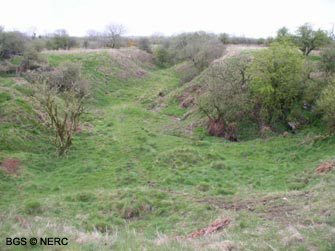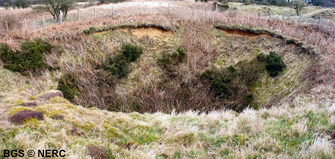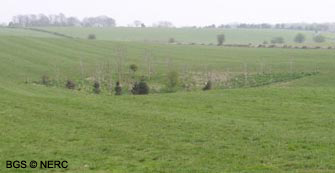
Quarrying and the environment

The Mendip Hills contain some thousands of closed hollows known as sinkholes or dolines. These are generally small but can be up to 20 m in depth and 100 m or more in diameter. Sinkholes develop by a variety of methods: collapse, suffosion or solution.
Collapse sinkholes form when an underlying cave passage collapses forming a depression on the surface above. These sinkholes are actually quite rare, as caves are generally quite stable. Around Smitham Hill, there are some examples where collapse of cavities within the underlying Carboniferous Limestone, aided by leakage though a thin cover of Jurassic or Triassic mudstone, has propagated up to the surface creating a sinkhole. Sandpit Hole, near Priddy, is another example of a collapse sinkhole.

Most sinkholes form by the process of ‘suffosion’. This is where loose, unconsolidated material including soil, ‘head’, loess and clay overlies fissures and joints in the underlying limestone, and material is washed into these fissures and into the caves beneath. Suffosion sinkholes tend to develop gradually (over months or years) as the covering sediment slumps into open fissures in the underlying limestone, creating a void which migrates towards the surface eventually creating a sinkhole.

Solution sinkholes form by the uneven dissolution of the underlying limestone, creating a broad saucer-like sinkhole. A good example is Bishops Lot on the road between Milton, near Wells and the Hunter’s Lodge Inn in Priddy. Others occur where a stream sinks underground, creating a blind valley.
Although a natural process, the formation of sinkholes is often accelerated or triggered by human actions. Broken land drains, water mains and sewerage pipes, increased rainfall, storm events, modified drainage and diverted surface water can all help wash sediment into the underlying limestone, causing subsidence. There have been many well documented occurrences of sinkholes forming beneath broken water mains, unlined storm-water culverts and leaking swimming pools.
- Home
- Overview maps
- Locality
areas
- Cheddar Gorge
- Charterhouse
- Blackdown
- Burrington Combe
- Shipham & Rowberrow
- Crook Peak & Axbridge
- Banwell to Churchill
- Priddy
- Harptree & Smitham Hill
- Draycott & Westbury-sub-Mendip
- Wookey Hole & Ebbor Gorge
- Wells
- Great Elm & Vallis Vale
- Mells & the Wadbury Valley
- The Vobster area
- The Whatley area
- Torr Works & Asham Wood
- Beacon Hill
- Stoke St Michael & Oakhill
- Holwell & Nunney
- Shepton Mallet & Maesbury
- Gurney Slade & Emborough
- The Nettlebridge valley
- Geology
- Minerals and mines
- Quarrying
- Caves and karst
- Biodiversity
- Detailed site information
- Acknowledgements
- External links
- Search
- Site map